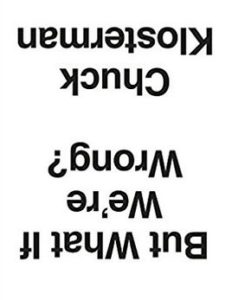But What If We’re Wrong? Thinking About the Present As If It Were the Past by Chuck Klosterman looks at present issues as if they were being viewed in the past. Explaining how we live now as if now was then is a fun and somewhat ridiculous exercise. He writes about gravity, time, rock music, television, and more. If you’re familiar with Klosterman’s work, it fits with his interesting writing. One area he doesn’t touch on is the environment. In fact, he states he’s not going to touch on the environment. I can think of many reasons he chose not to address the environment. For one, he may not have wanted the issue to become politicized. Unfortunately, this happens too often with environmental discussions. That’s what I’m here to do. I’ll play this game and make environmental predictions about the issues of today as if they were in the past.
The first area to address is climate change. The science of the past 40 years has provided a foundation of what is already occurring and what we can expect. Now let’s try to look at today as if it were the past; the distant past: 50, 100, 500 years from now. Here are 3 possible scenarios that historians will be studying.
- Our climate science was primitive. All sciences evolve and improve. Climate science will continue to provide even more information about the impacts. We’ve been predicting similar outcomes of climate change since the 1970s. The predictions keep improving based on new research, technology, and experience. How much more will it advance in the next 50 years? Maybe climate historians will say things like, “It’s a shame they didn’t have the XT5000 Climate Model in the early 2000s.”
- We were missing or overlooking a then-known factor. How do we know what we’re missing if we don’t know what it is? A future earth scientist will discover something in the rocks, ice, plants, or atmosphere that will change how we research climate change. Maybe we’ll discover a method to chemically break down greenhouse gases carbon dioxide or methane. We may create a reliable man-made method to control the atmosphere. This will allow us to adjust the amount of reflected and refracted sunlight, which will help us manually regulate the earth’s temperature.
- How did they not act on this sooner, despite the knowledge they had? This is easier to comprehend, but harder to take. Especially since we are living through a period of irresponsible decision-making. For example, the current head of the EPA stated that science should not dictate policy.
Climate change is the biggest present day environmental story. Making environmental predictions regarding areas other than climate change is more challenging. Other environmental areas that we are addressing include waste management, natural resources (habitats, species), cultural resources (historical properties), land use, toxins, cleaning up contaminated sites, and clean air and water. So what’s left?
Two current under the radar issues that will become relevant are light and noise pollution. Theses areas are being researched, but they’re not topics you’re not going to hear about often. They’re not sexy, high-profile areas. Historians will look back at today as a time when we could have taken more steps to reduce these impacts, but were focused on other areas.
Light and noise pollution will impact our health and the behavior of ecosystems. Population increase will continually create larger, brighter urban areas. How long until the earth becomes more like Coruscant? (Star Wars fans?) As this happens we will uncover more impacts from excessive light pollution. For example, a recent study states that outdoor light at night is linked with increased breast cancer risk in women. In the fight against cancer, did you ever consider that light pollution could be a factor? The problems with light pollution, for humans, plants, and animals are that it disrupts circadian rhythms and melatonin levels, disrupts ecosystems by confusing nocturnal animals, pollinators, and migrating birds.
Noise pollution is more of the same. Increased urbanization and industrialization leads to more noise around the clock. The impacts go beyond increased hearing loss. Other health impacts are cardiovascular, stress, sleep loss, higher levels of birth defects in mothers exposed to elevated noise, and more. An article I came across while writing this post was headlined, Noise is the biggest source of oil and gas complaints in Colorado. Noise! Not oil spills, not air pollution, not the smell or the sight, not fracking, but noise.
The impacts of light and noise pollution are presently being studied. But they’re not on the minds of our society and therefore way under the radar. We’ve improved our management of toxins, waste management, and species management. It will be years until we have legitimate policy and decision-making managing large-scale light and noise pollution. They will become the hot-button environmental issues of tomorrow.
Have you experienced any ill effects from light or noise pollution? In the future, maybe we all will. I’ll end with my favorite environmental comic. It is as relevant today as when it was first published years ago.


